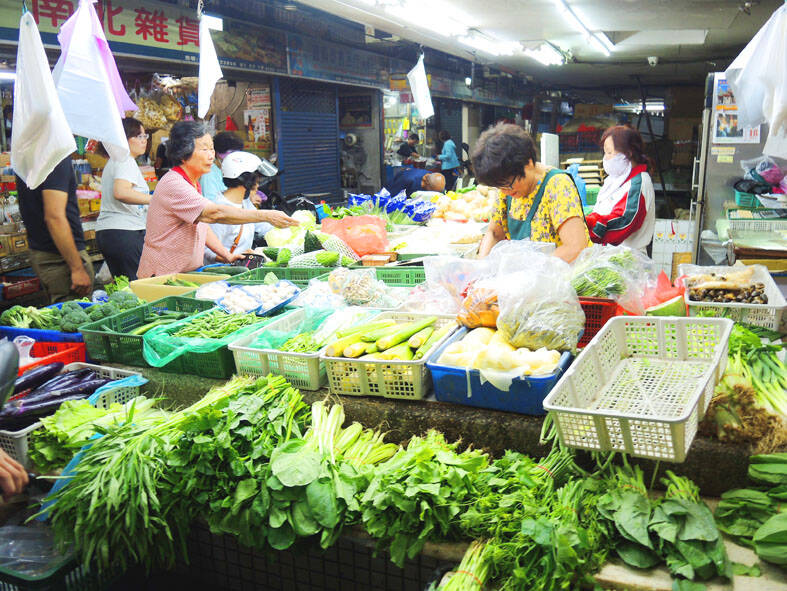Taiwan’s consumer price index (CPI) rose 1.54 percent year-on-year last month, a modest acceleration from June’s 1.36 percent increase, yet remained comfortably below the central bank’s 2 percent inflation threshold for the third consecutive month, the Directorate-General of Budget, Accounting and Statistics (DGBAS) said yesterday.
The uptick was primarily driven by a sharp rise in food prices following weather-related disruptions.
Vegetable prices surged 15.87 percent from June after Typhoon Danas and sustained heavy rainfall disrupted agricultural supply chains, particularly in southern Taiwan.

Photo: Chen Kuan-bei, Taipei Times
On an annual basis, vegetable prices increased 5.72 percent — a relatively muted gain due to a high comparison base in July last year, DGBAS official Tsao Chih-hung (曹志弘) said.
Lingering supply constraints are likely to keep vegetable prices elevated through this month, although the overall impact on inflation might be contained by similar price spikes in August last year, which create a high base effect, Tsao said.
Prices for essential goods rose 1.79 percent year-on-year — the largest increase in 17 months — driven by a rebound in egg prices following an 18-month decline, alongside continued price increases for pork, chicken and bread.
The jump in egg prices was attributed to stronger demand, partly in response to higher vegetable prices, as well as supply disruptions caused by the storm, Tsao said.
Core CPI, a more reliable price gauge because it excludes food, energy and other volatile items, rose 1.7 percent, marking the 16th consecutive month below the 2 percent threshold, suggesting that broader inflationary pressures remain well contained, he said.
Asked about the inflationary implications of the 20 percent tariff the US is to impose on Taiwanese goods starting today, Tsao said the impact is expected to be limited.
The latest rate is well below the 32 percent initially proposed in April, he said, adding that global demand has already weakened, contributing to a broad decline in international commodity prices and easing import cost pressures.
The New Taiwan dollar’s appreciation against the US dollar has further helped mitigate imported inflation, Tsao said.
Meanwhile, the producer price index (PPI), a key indicator of upstream and wholesale costs, fell 6.44 percent year-on-year last month, widening from a revised 5.35 percent decline in June, the DGBAS said.
The drop reflects broad-based softness in global commodity prices, particularly across minerals, chemicals, metals and electronics, the agency said.
The stronger local currency also played a role in reinforcing deflationary pressures on input costs.
“Overall, ‘reciprocal’ tariffs can generate both inflationary and deflationary effects, but under current conditions, the deflationary impact is likely to outweigh,” Tsao said.
For the first seven months of the year, the CPI rose 1.87 percent from the same period last year, while the PPI declined 0.69 percent, the DGBAS said.

WEAKER ACTIVITY: The sharpest deterioration was seen in the electronics and optical components sector, with the production index falling 13.2 points to 44.5 Taiwan’s manufacturing sector last month contracted for a second consecutive month, with the purchasing managers’ index (PMI) slipping to 48, reflecting ongoing caution over trade uncertainties, the Chung-Hua Institution for Economic Research (CIER, 中華經濟研究院) said yesterday. The decline reflects growing caution among companies amid uncertainty surrounding US tariffs, semiconductor duties and automotive import levies, and it is also likely linked to fading front-loading activity, CIER president Lien Hsien-ming (連賢明) said. “Some clients have started shifting orders to Southeast Asian countries where tariff regimes are already clear,” Lien told a news conference. Firms across the supply chain are also lowering stock levels to mitigate

IN THE AIR: While most companies said they were committed to North American operations, some added that production and costs would depend on the outcome of a US trade probe Leading local contract electronics makers Wistron Corp (緯創), Quanta Computer Inc (廣達), Inventec Corp (英業達) and Compal Electronics Inc (仁寶) are to maintain their North American expansion plans, despite Washington’s 20 percent tariff on Taiwanese goods. Wistron said it has long maintained a presence in the US, while distributing production across Taiwan, North America, Southeast Asia and Europe. The company is in talks with customers to align capacity with their site preferences, a company official told the Taipei Times by telephone on Friday. The company is still in talks with clients over who would bear the tariff costs, with the outcome pending further

Six Taiwanese companies, including contract chipmaker Taiwan Semiconductor Manufacturing Co (TSMC, 台積電), made the 2025 Fortune Global 500 list of the world’s largest firms by revenue. In a report published by New York-based Fortune magazine on Tuesday, Hon Hai Precision Industry Co (鴻海精密), also known as Foxconn Technology Group (富士康科技集團), ranked highest among Taiwanese firms, placing 28th with revenue of US$213.69 billion. Up 60 spots from last year, TSMC rose to No. 126 with US$90.16 billion in revenue, followed by Quanta Computer Inc (廣達) at 348th, Pegatron Corp (和碩) at 461st, CPC Corp, Taiwan (台灣中油) at 494th and Wistron Corp (緯創) at

NEGOTIATIONS: Semiconductors play an outsized role in Taiwan’s industrial and economic development and are a major driver of the Taiwan-US trade imbalance With US President Donald Trump threatening to impose tariffs on semiconductors, Taiwan is expected to face a significant challenge, as information and communications technology (ICT) products account for more than 70 percent of its exports to the US, Chung-Hua Institution for Economic Research (CIER, 中華經濟研究院) president Lien Hsien-ming (連賢明) said on Friday. Compared with other countries, semiconductors play a disproportionately large role in Taiwan’s industrial and economic development, Lien said. As the sixth-largest contributor to the US trade deficit, Taiwan recorded a US$73.9 billion trade surplus with the US last year — up from US$47.8 billion in 2023 — driven by strong